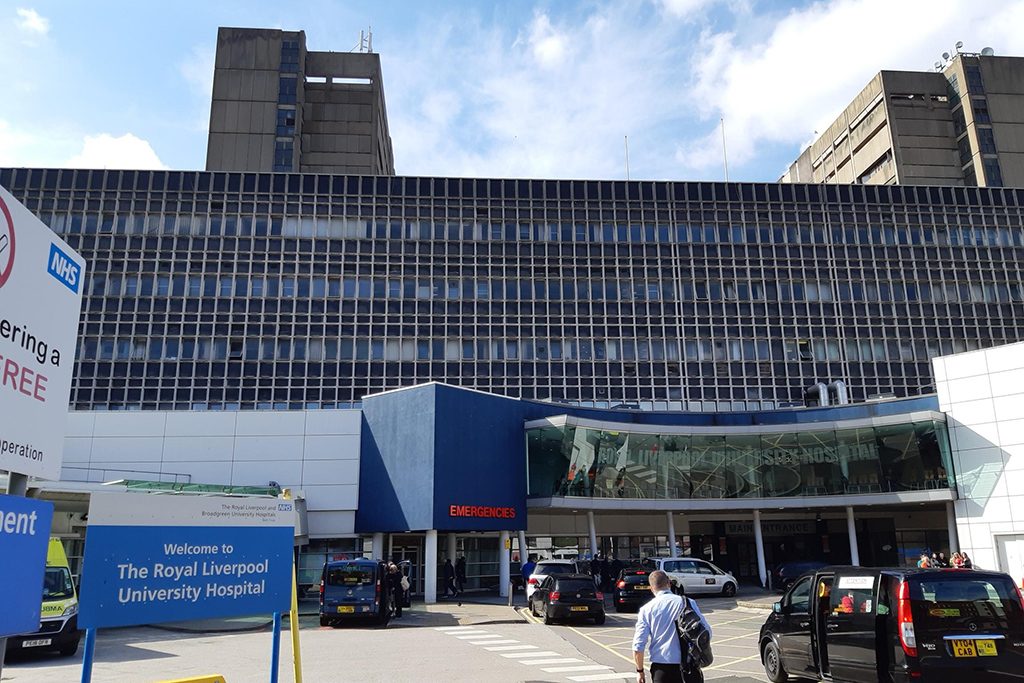By Andy Ford, Unite NHS rep
The iconic Royal Liverpool Hospital was supposed to be rebuilt and open to the public in 2017. In the event it was built using the Private Finance Initiative (PFI) at a cost of over £1 billion as opposed to the £624 million it would have cost through normal public procurement.
Worse than that, the PFI project was entrusted to Carillion, who subsequently went bankrupt. When new contractors eventually arrived on site, they found that three floors were of substandard build quality, with cracked and defective concrete, used by Carillion’s sub-contractors. They also had to remove thousands of square metres of dangerous cladding. As a result, far from opening in 2017, the Trust management are left “hoping for summer 2022”, five years late!
The actions of local and national Labour politicians has been poor. The original PFI was approved by none other than Andy Burnham, then Minister for Health. Then, when Merseyside Keep Our NHS Public (KONP) had the temerity to point out the hugely unnecessary cost of the PFI, they were assailed by an unholy alliance of Tory MPs, like Esther McVey, the local media led by the Liverpool Echo, and the now-disgraced Liverpool Mayor, Joe Anderson, for “blocking a new hospital for the people of Liverpool”.
Judicial reviews eventually failed
This rag tag of early PFI apologists even had the effrontery to publicly name and castigate individual members of KONP for explaining the true costs and seeking a judicial review of this ludicrous scheme. The judicial review eventually failed, after lobbying by a right-wing Labour councillors led to the legal aid for KONP being stopped.
The following is an extract from an article by Greg Dropkin of KONP, first published in October 2018. It is a few years old, but it gives the full story on what has indeed been a shameful fiasco of profiteering, incompetence and bullying – but also courage against the odds, and solid hard work from KONP.
Royal Liverpool PFI collapse vindicates KONP campaign, by Greg Dropkin
Over ten years ago, Keep Our NHS Public campaigners began a campaign in conjunction with Unison and the joint staff-side at the Royal Liverpool Hospital. Our aim was to stop the Private Finance Initiative (PFI) plans, and demand public finance for the new Royal.
We demonstrated outside the hospital and marched through the city on the 60th birthday of the NHS. Our member, Sam Semoff, brought two judicial reviews against the plans, the first of which forced the Trust to re-run their public consultation, which had not even mentioned PFI.

The scheme was approved by Andy Burnham, as Health Secretary, on the eve of the 2010 general election, and our campaign was opposed by the Trust and local Labour politicians, and vilified in the Liverpool Echo. On November 17, 2010, BBC Radio Merseyside put Sam up against Joe Anderson, then Leader of the Liverpool City Council and now Liverpool Mayor, who angrily declared “I know it doesn’t provide value for money now or in the future, but it’s the only game in town”.
That admission ricocheted all the way up to a Treasury Select Committee Inquiry into PFI. An Echo article headlined “Bogoff Semoff” painted Sam as the American standing between Liverpool and a new hospital. “Value for money” was challenged in a second judicial review, but it was derailed when the Deputy Leader of Liverpool City Council approached the Legal Assistance Board and persuaded them to pull the funding.
Public not told that finance was by PFI
As set out in the Treasury Select Committee report and in written evidence from KONP Merseyside, PFI schemes are riddled with questionable assumptions behind the claims of value for money. In Liverpool, this was compounded by secrecy which prevented democratic accountability.
During the initial consultation in 2008, the public was not told that PFI would be used to finance the scheme. The High Court then forced a second “engagement exercise” with the public now informed of PFI. However, the Outline Business Case was not disclosed and there was no means to question any of its assumptions. The scheme’s approval was announced in the press by the then Secretary of State for Health, [Andy Burnham] in late March 2010, though in fact the scheme was only given final approval in mid-April. The Outline Business Case was eventually published after the general election.
Thus, throughout the entire period of two public consultations, and even after final approval from the then Secretary of State, the public did not know exactly what the scheme entailed, whether it would provide value for money or be affordable. Instead, the scheme was reviewed internally by the Department of Health and the Treasury. Without a legal challenge, the failings identified by senior officials at the Dept of Health would have remained hidden from the public.
Questionable assumptions and violations of policy
Solicitors Leigh Day, public health economist, Mark Hellowell, and KONP uncovered strong evidence that the scheme would not provide value for money, and internal documents from the Dept of Health acknowledged this in December 2009. The scheme was subsequently revised but still involved several questionable assumptions and violations of Treasury policy. The withdrawal of Legal Aid prevented the evidence from being tested in the High Court.

Had any of the errors been corrected, the scheme would have failed the Treasury’s VfM assessment. Even with these errors, the scheme’s VfM assessment found only an 0.03% advantage for PFI over conventional procurement. In any case, uncertainty in the parameter values – which are only predictions – meant there was no significant advantage in PFI over conventional procurement. It sailed through, regardless.
By hook or by crook, the scheme cleared every hurdle. The contract went to Carillion, whose record of blacklisting construction workers and racist bullying of ancillary staff at Great Western Hospital in Swindon, was shown to the Trust and Liverpool City Council before the deal was done.
At the time, it felt like a crushing defeat, and we could only say that the price had eventually gone down, possibly because of the campaign. Now the PFI lies in ruins, the half-built hospital has major construction faults, and the government has had to step in with public finance.
The outcome vindicates our campaign, but it is not a complete victory. With the collapse of Carillion, subcontractors are still waiting to be paid. The new hospital is not expected before 2020 [now 2022 – AF], and staff will struggle on amidst maintenance problems in the existing site. The Trust will be paying some of the investors’ costs, despite the so-called “transfer of risk” to the private sector.
But if public finance for the Royal Liverpool hospital signals the end of PFI in the NHS – and the rest of the public sector – it really will be a victory.
The current situation
On September 25, 2018, the Royal Liverpool & Broadgreen University Hospital Trust announced that the PFI scheme would be terminated and The Hospital Company (Liverpool) will “hand over its contracts for construction, supply chain and facilities management, to the Trust, over the course of the next few months.”
As Construction News reported, Health minister Stephen Barclay confirmed that the government would step in, backing plans by the NHS trust to terminate its PFI deal. The trust will be required to make a payment to the lenders – the European Investment Bank (EIB) and Legal & General – for work done to date. However, this will not cover the full value of the lenders’ contributions to the project.
A spokesperson for the EIB said: “Joint lenders EIB and Legal and General expect to face significant losses under the termination agreement. Precise details of this agreement are currently being finalised.” Appointing a new contractor to replace Carillion had been complicated by the discovery of problems with the cladding after a survey. This was in addition to problems with concrete beams in the building that were known about prior to Carillion’s collapse.
Ending PFI
Here in Liverpool, we do not yet know the extent of structural damage – which may require the new Royal to be torn down and rebuilt from scratch – nor the extent to which the Trust will compensate investors for their losses, which means taking money out of patient care after a scheme whose failings were known in advance, collapsed.
But looking further ahead, Shadow Chancellor John McDonnell has pledged to bring existing PFI contracts in-house. One means of doing so, supported by the campaign group People vs PFI, would be to nationalise the Special Purpose Vehicles before they collapse, rather than transferring PFI debt to the Treasury. This strategy is set out in a paper by Helen Mercer and Dexter Whitfield.
Let’s hope that the Liverpool fiasco opens the space for new thinking.



